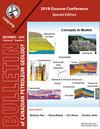Regional T-R sequence stratigraphy and lithostratigraphy of the Bearpaw Formation (Upper Campanian), west-central and southwestern Alberta plains
Q3 Earth and Planetary Sciences
引用次数: 2
Abstract
Abstract In west-central and southwestern Alberta, the lower and upper tongues of the marine mudstone-dominated Bearpaw Formation have a complex lateral relationship with marginal marine and non-marine strata of the Horseshoe Canyon and Blood Reserve formations. Wireline log, core and outcrop data permit the establishment of a regional transgressive-regressive (T-R) sequence stratigraphic framework for the upper Campanian Bearpaw strata. This provides a context within which lithostratigraphic boundaries of the Bearpaw tongues with laterally equivalent and overlying strata can be more rigorously mapped. Maximum flooding (MFS) and transgressive (TS) surfaces were defined on the basis of stratal stacking patterns and inferred lapout relationships wherever possible. Lower Bearpaw tongue and laterally equivalent strata are assigned to four regionally mappable T-R sequences. In the study area the top of the underlying Belly River Group is placed at the MFS in the lowermost of these sequences. In the overlying lower Bearpaw sequences, the TS is generally considered to coincide with the MFS within the limits of wireline log resolution, and the succession consists mainly of stacked regressive systems tracts which usually show a near-parallel internal stratal geometry. Upper Bearpaw tongue and laterally equivalent strata are assigned to three regionally mappable T-R sequences. The basal upper Bearpaw sequence has a well-developed transgressive systems tract consisting of backstepping, individually regressive parasequences, and southeast-prograding clinoform geometry is clear in each of the upper Bearpaw tongue regressive systems tracts. The lithostratigraphic upper boundaries of the lower and upper Bearpaw tongues are time-transgressive facies contacts that step up-section to the southeast (paleoseaward) through the respective regressive systems tracts. The base of the upper Bearpaw tongue steps up-section from the basal TS of the lowermost sequence in the southeast, through the overlying transgressive systems tract, to coincide with the maximum flooding surface to the northwest (paleolandward).阿尔伯塔平原中西部和西南部上坎帕尼亚区熊掌组区域T-R层序地层学和岩石地层学
在阿尔伯塔省中西部和西南部,以海相泥岩为主的Bearpaw组上下舌与Horseshoe Canyon组和Blood Reserve组的边缘海相和非海相地层有着复杂的侧向关系。电缆测井、岩心和露头资料为坎帕统上熊掌地层建立了区域性海侵-退(T-R)层序地层格架。这提供了一个背景,在此背景下,可以更严格地绘制具有横向等效和上覆地层的熊掌舌的岩石地层边界。最大淹水面(MFS)和海侵面(TS)的定义是基于地层叠加模式和尽可能推断的拉出关系。下熊掌舌和侧向等效地层划分为4个区域可测的T-R层序。在研究区,下伏的贝勒河群顶部位于这些层序中最下部的MFS。在上覆的下Bearpaw层序中,通常认为在电缆测井分辨率的限制下,TS与MFS重合,演替主要由叠加的回归系统域组成,通常显示出接近平行的内部地层几何形状。上熊掌舌和侧向等效地层划分为3个区域可测的T-R层序。基底上熊爪层序具有发育良好的海侵体系域,由退步、单独退退的准层序组成,上熊爪舌上各退退体系域均具有明显的东南进斜形几何特征。下、上熊掌舌的岩石地层上边界为时间海侵相触点,通过各自的回退体系域向东南方向(古海向)递进。上熊爪舌的底部从东南最底层序的基底TS开始向上延伸,穿过上覆的海侵体系域,与西北(古陆方向)的最大淹水面重合。
本文章由计算机程序翻译,如有差异,请以英文原文为准。
求助全文
约1分钟内获得全文
求助全文
来源期刊

Bullentin of Canadian Petroleum Geology
Earth and Planetary Sciences-Geochemistry and Petrology
CiteScore
2.50
自引率
0.00%
发文量
0
期刊介绍:
The Bulletin of Canadian Petroleum Geology is a peer-reviewed scientific journal published four times a year. Founded in 1953, the BCPG aims to be the journal of record for papers dealing with all aspects of petroleum geology, broadly conceived, with a particularly (though not exclusively) Canadian focus. International submissions are encouraged, especially where a connection can be made to Canadian examples.
 求助内容:
求助内容: 应助结果提醒方式:
应助结果提醒方式:


